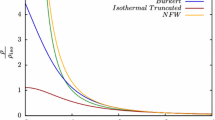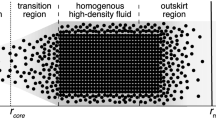Abstract
Although the existence of dark matter is generally accepted by the mainstream scientific community, there is no generally agreed direct detection of it. Also, observations show that some Bok globules are prolate in some regions without suitable explanation for its cause. In this paper, we investigate the effect of dark matter sub-halo in transformation of the Bok globules from spherical to the prolate shape. We limit the investigation to a particular case that the magnetic field and turbulent effects are negligible through the Bok globule. We consider the gravitational effect of dark matter sub-halo on the isothermal Bok globule that is exposed to suitable distance of it. The results show that the dark matter sub-halo can justify the transformation of Bok globules in some regions. In this paper, we introduce a new method for proving the existence of dark matter sub halo.




Similar content being viewed by others
References
Bok, B., Reilly, E.: Astrophys. J. 105, 255 (1947)
Clemens, D.P., Barvainis, R.: Astrophys. J. Suppl. Ser. 68, 257 (1988)
Henning, Th., Wolf, S., Launhardt, R., Waters, R.: Astrophys. J. 561, 871 (2001)
Kandori, R., Nakajima, Y., Tamura, M., et al.: Astrophys. J. 130, 2166 (2005)
Oort, J.H.: Bull. Astron. Inst. Neth. 6, 249 (1932)
Ryden, B.S.: Astrophys. J. 471, 822 (1996)
Spark, L.S., Gallagher, J.S.: Galaxies in the Universe: An Introduction. Cambridge University Press, Cambridge (2007)
Stahler, S.W., Palla, F.: The Formation of Stars. Wiley-VCH, New York (2004)
Trimble, V.: Annu. Rev. Astron. Astrophys. 25, 425–472 (1987)
Wolf, S., Launhardt, R., Henning, T.: Astrophys. Space Sci. 292, 239 (2004)
Zwicky, F.: Helv. Phys. Acta 6, 110 (1933)
Author information
Authors and Affiliations
Corresponding author
Appendix: The finite difference method
Appendix: The finite difference method
In this appendix, we describe the numerical technique, which is used to solve Eq. (11). Here, we use an equally spaced mesh points. The number of points for r-component are M+1, and for θ-component are N+1, and spacing between points are h r and h θ , respectively. Also, index j is used for r-component and n is used for θ-component. In \(\tilde{r}=0\), we have
and since its gradient at \(\tilde{r}=0\) is zero, we have
For other mesh points, density can be obtained from Eq. (11) as follows
For example, we can write \(\tilde{\rho}(2,n)\) as follows
where is related only to \(\tilde{\phi^{*}}(1,n)\). Knowing \(\tilde{\rho}(2,n)\), we can find \(\tilde{\rho}(3,n)\) and so on.
Rights and permissions
About this article
Cite this article
Gholipour, M., Nejad-Asghar, M. The prolate Bok globules evidence for the existence of dark matter sub-halo. Astrophys Space Sci 349, 401–405 (2014). https://doi.org/10.1007/s10509-013-1643-7
Received:
Accepted:
Published:
Issue Date:
DOI: https://doi.org/10.1007/s10509-013-1643-7




